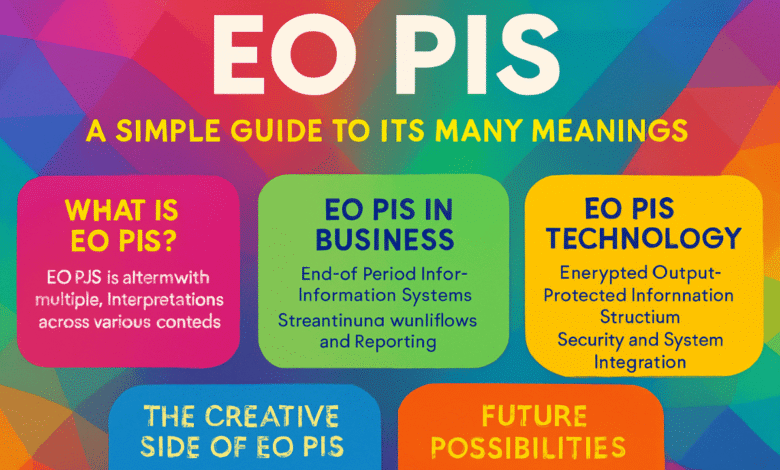EO PIS: A Simple Guide to Its Many Meanings

In today’s fast-evolving digital and business landscape, certain terms emerge with multiple meanings, sparking curiosity and debate. One such term is EO PIS, a phrase that has gained attention across industries—from business operations to technology and even creative fields. But what exactly does EO PIS mean, and why is it relevant?
This article dives deep into the concept of EO PIS, exploring its different interpretations, applications, and potential future uses. Whether you’re a business professional, a tech enthusiast, or simply someone intrigued by unique terminologies, this guide will provide clarity on EO PIS and its significance.
1. What Is EO PIS? Breaking Down the Term
EO PIS is a term that doesn’t have a single, fixed definition. Instead, its meaning shifts depending on the industry or context in which it’s used. Some interpret it as an acronym, while others see it as a symbolic or abstract concept.
In business, EO PIS often refers to End-of-Period Information Systems, a structured approach to finalizing financial or operational data at the end of a reporting cycle. This ensures accuracy and compliance before data is submitted for audits or decision-making.
In technology, EO PIS might stand for Encrypted Output – Protected Information Structure, a security framework for safeguarding sensitive data. Some also associate it with internal project codenames in software development.
Meanwhile, in creative and internet culture, EO PIS has been used as a cryptic phrase—appearing in music, digital art, and even memes—where its meaning is left open to interpretation.
Read also: Doge Software Licenses Audit HUD: Exposing Government Waste and Improving Compliance
2. EO PIS in Business: Streamlining Workflows and Reporting
One of the most practical applications of EO PIS is in business operations, particularly in finance and data management. Companies rely on structured processes to close monthly, quarterly, or yearly reports efficiently.
Key Aspects of EO PIS in Business
- Automated Data Validation – Reduces human error by cross-checking figures before final submission.
- Reconciliation Processes – Ensures that all transactions match across different systems.
- Exception Handling – Flags discrepancies for review before reports are finalized.
Businesses that implement EO PIS methodologies experience fewer delays in financial reporting and maintain better compliance with industry regulations.
3. EO PIS in Technology: Security and System Integration
The tech world often uses EO PIS in relation to cybersecurity and system architecture. Some interpretations include:
Encrypted Output – Protected Information Structure
This refers to a security model where sensitive data is encrypted before being transmitted or stored. Companies handling confidential information—such as banks or healthcare providers—may use EO PIS protocols to prevent breaches.
Endpoint Operations – Process Integration System
Another tech-related meaning of EO PIS involves integrating various software tools to create seamless workflows. For example, a company might use EO PIS to connect its CRM, accounting software, and inventory management system for real-time updates.
4. The Creative Side of EO PIS: Art, Music, and Internet Culture
Beyond business and tech, EO PIS has found a place in creative expression. Some musicians and artists have used the term in album titles or as part of abstract themes, giving it a mysterious and thought-provoking appeal.
Online communities have also embraced EO PIS as a meme or inside joke, with users debating its origins and hidden meanings. This cultural phenomenon shows how a simple term can evolve beyond its technical roots into something more symbolic.
5. Future Possibilities: Where Could EO PIS Go Next?
Given its flexible nature, EO PIS has the potential to expand into new areas. Some emerging trends include:
- AI-Driven Analytics – Tools like Enhanced Online Publishing Information System (EO PIS) could help bloggers and marketers optimize content performance.
- Branding and Minimalist Design – Companies might adopt EO PIS as a brand philosophy, representing simplicity and efficiency.
- Philosophical and Conceptual Frameworks – Thinkers may explore EO PIS as a metaphor for structured thinking in chaotic environments.
Conclusion
EO PIS is a term that defies a single definition, making it both fascinating and versatile. Whether viewed as a business process, a tech security measure, or a creative enigma, its applications are wide-ranging.
As industries continue to evolve, EO PIS may take on new meanings, further embedding itself into professional and cultural discussions. For now, understanding its various interpretations helps demystify the term and highlights its relevance across different fields.
By exploring EO PIS in depth, we uncover not just a keyword, but a concept that bridges functionality, security, and creativity—proving that even the most ambiguous terms can hold significant value.
Frequently Asked Questions (FAQs) About EO PIS
1. What does EO PIS stand for?
EO PIS has multiple meanings depending on the context. In business, it can refer to End-of-Period Information Systems, a structured process for finalizing reports. In technology, it may stand for Encrypted Output – Protected Information Structure or Endpoint Operations – Process Integration System. It also appears in creative fields as an abstract or symbolic term.
2. How is EO PIS used in business operations?
In business, EO PIS helps streamline workflows, particularly in financial reporting. It includes automated data validation, reconciliation, and exception handling to ensure accuracy before finalizing monthly or quarterly reports.
3. Is EO PIS related to cybersecurity?
Yes, in tech, EO PIS can refer to security frameworks like Encrypted Output – Protected Information Structure, which protects sensitive data through encryption. It may also relate to secure system integrations in enterprise software.
4. Why is EO PIS sometimes considered mysterious?
Because it lacks a single fixed definition, EO PIS has been adopted in creative and internet culture as a cryptic phrase—appearing in music, memes, and digital art—where its meaning is left open to interpretation.
5. Could EO PIS be used in content creation or blogging?
Potentially. Some speculate about tools like Enhanced Online Publishing Information System (EO PIS) that could optimize content using AI-driven analytics, though this remains an emerging concept.
6. Is EO PIS an official term, or is it made up?
It appears in some professional contexts (e.g., business workflows, tech security), but its ambiguity means it’s also used informally in creative and online spaces.
7. How can businesses implement EO PIS?
By adopting structured processes for data validation, integrating automation tools, and ensuring compliance checks during reporting cycles.
8. Are there any controversies around EO PIS?
No major controversies exist, but its vague nature sparks debates online—some treat it as an inside joke, while others analyze it as a technical term.
9. Will EO PIS become more important in the future?
Possibly. As data security and workflow efficiency grow in priority, EO PIS (or similar frameworks) could gain traction in tech and business.
10. Where can I learn more about EO PIS?
Research industry-specific uses (e.g., finance, cybersecurity) or explore its cultural presence in art and online communities.



